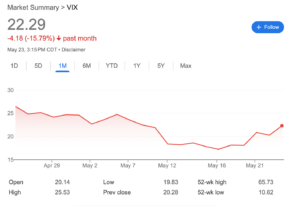Market Overview
The U.S. stock market faced a turbulent week ending May 23, 2025, as investor confidence wavered. Major indices declined, reflecting concerns over U.S. debt, rising interest rates, and trade policy uncertainties. Despite these challenges, strategic asset allocation remained crucial for portfolio resilience. The 4th industrial revolution, driven by AI and quantum computing, continued to shape long-term investment strategies.
Major Indices
The week saw broad-based declines across major indices. The S&P 500 fell 1.94%, closing at 5,844.61, while the Nasdaq dropped 1.66% to 18,872.64. The Dow Jones Industrial Average declined 2.29% to 41,860.44, and the Russell 2000 shed 2.25% to 2,105.58. These losses, approximately 2-3% weekly, marked a 5% retreat from recent highs, signaling a shift from the prior four-week rally.
Key Market Trends & News
Several factors contributed to the market’s downturn. The U.S. debt crisis intensified, with Moody’s downgrade amplifying fears of a 106% debt-to-GDP ratio by 2028. A tax bill passed by the House, influenced by President Trump, raised concerns about fiscal strain, with annual interest costs projected at $880 billion. Trump’s tariff threats, including 50% on Europe and 25% on smartphones, reignited trade war fears, impacting retailers like Target and Walmart.
Geopolitical tensions, including Israel’s threats against Iran and Russia’s actions in Ukraine, drove safe-haven demand. Gold prices surged to $3,365, and Bitcoin rose, reflecting risk aversion. The 4th industrial revolution gained traction, with Google’s AI advancements and humanoid robot demos signaling rapid technological progress. However, stagflation concerns grew, with experts like Jamie Dimon warning of combined inflation and economic slowdown.
Interest Rates & Bond Market
The bond market saw heightened volatility. The 10-year Treasury yield climbed to 4.59%, and the 30-year yield hit 5.03%, a 20-year high. Rising yields increased borrowing costs, pressuring corporate and household finances. The Federal Reserve’s cautious stance on rate cuts, with a 94.4% chance of a July freeze, added uncertainty. Investors favored intermediate-term, high-credit-quality bonds to mitigate volatility.
Commodities Market
Safe-haven assets outperformed amid market unease. Gold surged 2% to $3,360, driven by tariff-induced economic fears. Bitcoin climbed to $93,500, supported by institutional interest from firms like MicroStrategy. Oil prices rose modestly, with West Texas Intermediate at $62.75 per barrel, despite low Chinese demand. Commodities offered diversification as investors hedged against inflation risks.
Major Tech Stocks Performance
Tech stocks faced broad declines, reflecting market sentiment. Apple dropped 3%, Tesla and Nvidia each fell 3%, Amazon declined 2%, Microsoft shed 0.90%, and Meta lost 2%. Alphabet bucked the trend, gaining 1.37%. Defensive stocks like Procter & Gamble showed resilience, while quantum computing firm IonQ surged 37% on optimism about its role in the 4th industrial revolution.
Market Sentiment & Flows
Market sentiment weakened, with the Fear & Greed Index dropping to 64 from 70, still in the greed zone. The VIX rose to 22.29, signaling increased volatility. Investors shifted to safe-haven assets, with put option buying surging. Money market funds held significant cash reserves, poised for deployment if positive signals emerge. This cautious sentiment underscored the need for strategic asset allocation.
Upcoming Key Economic Indicators & Events
The week ahead, starting with a Memorial Day closure on May 26, 2025, will feature critical economic data. Tuesday’s durable goods orders, Wednesday’s FOMC minutes and GDP growth, and Thursday’s personal income, spending, and inflation data could drive volatility. Nvidia’s earnings on Wednesday are pivotal, with strong guidance expected due to AI demand and partnerships with Oracle and Dell. June’s ISM Manufacturing, JOLTS, and nonfarm payrolls will also shape market direction.
Conclusion & Market Outlook
Despite last week’s declines, opportunities persist. The U.S. economy remains robust, with declining jobless claims, rising home sales, and a services PMI above 52. Trump’s flexible trade policies and potential U.S.-China tariff relief could stabilize markets. The 4th industrial revolution, fueled by AI and quantum computing, offers long-term growth potential. Investors should maintain strategic asset allocation, balancing equities, bonds, and commodities to navigate uncertainty. JPMorgan and Goldman Sachs estimate a recession probability below 50%, suggesting resilience. With Nvidia’s earnings and economic data looming, June could see renewed market vigor.
Disclaimer: This content is for informational purposes only and does not constitute financial advice. Consult a qualified financial advisor before making investment decisions.
